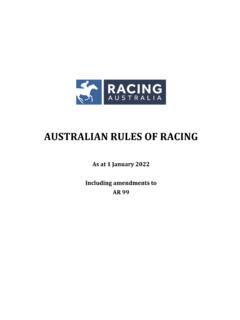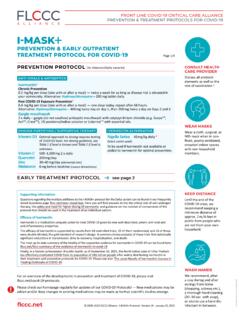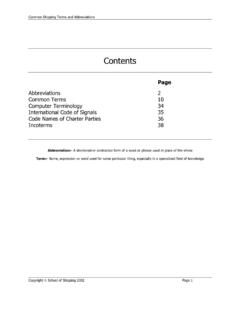Transcription of Applications of the Poisson probability distribution
1 SA12083 Applications of the Poisson probability Applications of the Poisson probability distribution Jerzy Letkowski Western New England University Abstract The Poisson distribution was introduced by Simone Denis Poisson in 1837. It has since been subject of numerous publications and practical Applications . The purpose of this paper is to raise awareness of numerous application opportunities and to provide more complete case coverage of the Poisson distribution . First a formal definition and basic characteristics of a Poisson variable and its distribution are summarized. Next cases, representing time and space oriented Poisson situations, are presented. probability assessment solutions, using functions built in spreadsheet programs, are presented. Finally, pedagogical issues, regarding challenges in teaching Statistics are discussed.
2 Keywords: statistics, probability , distribution , random variable, Poisson . SA12083 Applications of the Poisson probability Poisson VARIABLE AND distribution The Poisson distribution is a probability distribution of a discrete random variable that stands for the number (count) of statistically independent events, occurring within a unit of time or space (Wikipedia- Poisson , 2012), (Doane, Seward, 2010, ), (Sharpie, De Veaux, Velleman, 2010, p. 654 ), (Jaggia, S., Kelly, A., 2012, p. 157) , (Donnelly, 2012, p. 215), (Anderson, Sweeney, Williams, 2012, p. 236). Given the expected value, , of the variable, X, the probability function is defined as: ( )( )( ),..2,1,0 , ,!)(0===== == nkfnFnenXPnfnkknu A more generalized attempt to define this distribution is shown in (Levine, Stephan , Krehbiel, Berenson, 2011) where the unit of time or space is referred to as an area of opportunity (p.)
3 177). It is an interesting generalization of this important context of the Poisson distribution . Wolfram MathWorld (2012) arrives at this distribution by taking the limit of the Binomial (Bernoulli) distribution when the number, N, of trials becomes very large (N ). A Binomial random variable represents the number of successes in a series of independent and probabilistically homogenous trials (Wikipedia-Binomial, 2012). A relation of the Poisson distribution to the Binomial distribution is also motioned in (Pelosi, Sandifer, 2003) and (De Veaux, Velleman, Bock 2006, p. 388). Assessment of probabilities for Poisson variables is not complicated. There are many Web sites that provide calculators to this end (" Poisson Calculator ..", 2012). All major, contemporary statistical packages and spreadsheet programs are well equipped with functions for computing Poisson probabilities.
4 For example, Google spreadsheet and Microsoft Excel provide the same syntax for the distribution functions: P(X = n) = Poisson (n, , false), P(X n) = Poisson (n, , true) Notice that the last parameter of the Poisson function indicates whether or not the function returns the cumulative probability . An example for computing Poisson probabilities in a Google spreadsheet is shown in Figure 1 (Appendix). A similar function is available in the Open Office Spreadsheet program, = Poisson (x; ; 0|1). Notice that this spreadsheet program uses a semi-colon to separate the function's arguments. TIME ORIENTED Poisson VARIABLES Feller (1966, p. 17) shows how the Poisson distribution can be derived from a series of Exponentially distributed random variables, Sn = X1+ X2+..+ Xn. Considering a random variable, N(t), such that N(t) = max{n: Sn t} and given all variables Xk , k=1,2.
5 ,n, have the same exponential distribution , f(x) = e- x, x 0, the N(t) variable has this distribution : ()( ){}()( ){}(),..2,1,0 ,,, ,!)(),0== ==== == nktfntNPntFntentNPntfnkknt Consequently, the Poisson random variable can be "stretched" over longer or shorter time intervals. Since is the expected (average) number of events per one unit of time or space, t SA12083 Applications of the Poisson probability will be such a number per t units. One has to make sure that process N(t) is stationary within time interval (0,t). Whether one observes patients arriving at an emergency room, cars driving up to a gas station, decaying radioactive atoms, bank customers coming to their bank, or shoppers being served at a cash register, the streams of such events typically follow the Poisson process.
6 The underlying assumption is that the events are statistically independent and the rate, , of these events (the expected number of the events per time unit) is constant. The list of Applications of the Poisson distribution is very long. To name just a few more: The number of soldiers of the Prussian army killed accidentally by horse kick per year (von Bortkewitsch, 1898, p. 25). The number of mutations on a given strand of DNA per time unit (Wikipedia- Poisson , 2012). The number of bankruptcies that are filed in a month (Jaggia, Kelly, 2012 ). The number of arrivals at a car wash in one hour (Anderson et al., 2012, p. 236). The number of network failures per day (Levine, 2010, p. 197). The number of file server virus infection at a data center during a 24-hour period . The number of Airbus 330 aircraft engine shutdowns per 100,000 flight hours.
7 The number of asthma patient arrivals in a given hour at a walk-in clinic (Doane, Seward, 2010, p. 232). The number of hungry persons entering McDonald's restaurant. The number of work-related accidents over a given production time, The number of birth, deaths, marriages, divorces, suicides, and homicides over a given period of time (Weiers, 2008, p. 187). The number of customers who call to complain about a service problem per month (Donnelly, Jr., 2012, p. 215) . The number of visitors to a Web site per minute (Sharpie, De Veaux, Velleman, 2010, p. 654). The number of calls to consumer hot line in a 5-minute period (Pelosi, Sandifer, 2003, p. D1). The number of telephone calls per minute in a small business. The number of arrivals at a turnpike tollbooth par minute between 3 and 4 in January on the Kansas Turnpike (Black, 2012, p.)
8 161). Consider a simple emergency room example where 2 patients arrive, on average, every 10 minutes (this is equivalent to patients per one minute). Consecutive arrivals are statistically independent. This means that each given arrival has no impact on the probability of next arrivals. Letting N(t) represent the number of such arrival in t minutes, one can evaluate the following probabilities, using the Poisson distribution (as implemented in Excel or Google spreadsheet): P{N(60) = 10} = Poisson (10,60* ,False) = P{N(60) 10} = Poisson (10,60* ,True) = P{N(60) < 10} = Poisson (9,60* ,True) = P{N(60) > 10} =1- Poisson (10,60* ,True) = P{N(60) 10} =1- Poisson (9,60* ,True) = SA12083 Applications of the Poisson probability Notice that in real world situations, due to the aspect of "seasonality", the arrival rate may remain constant only within limited time intervals ("seasons").
9 In such situations, variable t must not go beyond the upper limits of such seasonal intervals. For example, a morning rate may stay constant between 5:00 and 11:00 , a noon rate between 1:00 and 2:00 , etc. Figure 2 (Appendix) shows implementation of the above formulas in a Google spreadsheet. Time based Poisson variables are more popular. One can find numerous examples and cases, involving such random variables in most to the contemporary statistical textbooks or papers. SPACE ORIENTED Poisson VARIABLES Space oriented Poisson variables are less common or popular. Nonetheless, one can find some interesting examples of such variables in most recent Statistics books. For example: The number of typographical errors found in a manuscript or the total number of home runs hit in Major League Baseball games (Donnelly, Jr.)
10 , 2012, p. 215). The number of surface defects on a new refrigerator or the number of fleas on the body of a dog (Levine et al., 2011, p. ). The number of blemishes per sheet of white bond paper (Doane, Seward, 2010, p. 232) . The number of repairs needed in 10 miles of highway or the number of leaks per 100 miles of pipeline (Anderson et al., 2012, p. 237). The number of defects in a 50-yard roll of fabric or the number of bacteria in a specified culture (Jaggia, Kelly, 2012, ). The number of defects that occur in a computer monitor of a certain size (Sharpie et al., 2010, p. 654). The number of a certain type of insect that can be found in a 1-square-foot area of farmland (Pelosi, Sandifer, 2003, p. D1). The number of hazardous waste sites per county in the United States or the number of sewing flaws per pair of jeans during production (Black, 2012, p.















